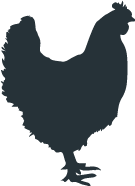Infectious coryza (IC) is an acute upper respiratory disease of chickens caused by
Avibacterium paragallinarum (previously referred to as
Haemophilus paragallinarum). IC occurs worldwide. Within the United States, it is most prevalent in California and the Southeastern states.
IC usually begins abruptly, with all susceptible chickens showing signs of disease within 24-72 hours after exposure to infection. The typical symptoms are facial swelling and sinuses with a clear discharge progressively becoming foul smelling and purulent. Roosters may have swollen wattles. There is marked conjunctivitis and lacrimation (tearing or watery eyes). Infected birds may have their eyes partially or completely closed due to the excessive eye discharge, making it difficult for them to see to eat and drink. The disease course in uncomplicated cases of IC is usually 7-11 days. If the disease is complicated by concurrent infections it can persist for a month and longer.
Diagnosis of Infectious Coryza
Diagnosis of IC is based on history, clinical signs, and bacteriological examinations of the suspected causal agent leading to isolation, and identification of the causative agent. There are many diagnostic laboratory tests available for detection of
A. paragallinarum, which include:
- Direct isolation: For direct isolation, the pathogen can be isolated from sterile cotton swabs obtained from the infraorbital sinus, trachea, and air sac. To be an effective form of diagnosis, the pathogen must be isolated during the acute stage of infection (1 to 7 days of the incubation period).
- Hemagglutination inhibition (HI) test: There are three main forms of HI tests available, which are widely used for detecting changes in antibody titers, in cases of field infection or vaccination, and for evaluating the prevalence of IC within flocks.
- PCR testing: PCR tests are available which provide rapid (often within 6 hours) results.
Diagnosis of infectious coryza can be more complicated when it occurs alongside other pathogens.
Infectious Coryza Transmission
The main reservoirs of infection for
A. paragallinarum are chronic or apparently healthy carrier birds. Once introduced into a flock,
A. paragallinarum is spread rapidly via direct or indirect contact with infected birds, through ingestion of contaminated feed or water, and by aerosols. Susceptible birds exposed to infected birds may show signs of the disease within 24-72 hours. Chickens who have recovered can become carriers, shedding the bactera when stressed.
